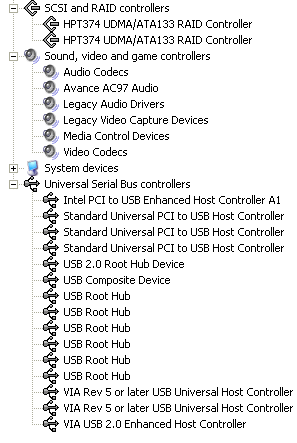Features continued.

The bottom left of the IT7 houses more integrated chips. On the left of the above picture we see the VIA VT6202 USB2.0 Host Controller. The controller supports 4 downstream USB2.0 ports, 2 are pre-soldered onto the backplane, and a further 2 are available from a separate header.
You also have the option of connecting up various external memory sources such as Sony's memory stick and Panasonic secure digital cards along with standard compact flash cards.
We also see the inclusion of a Realtek RTL8100BL 10/100 Base-T Fast Ethernet Controller. Onboard ethernet is becoming more and more prevalent nowadays with the increased use of networking and broadband internet. As the IT7 only has 4 PCI slots, it makes great sense to include an integrated ethernet connection. The RTL8100BL was an able substitute for my preferred NIC, the D-Link 530TX.
To the very right, you may be able to see the diminutive Realtek ALC650 5.1 sound CODEC. The ALC650 is an 18-bit, full duplex AC'97 2.2 compatible stereo audio CODEC. It natively supports full surround sound 5.1 configuration with a maximum of 6 separate or discrete channels (Left, Right, Center, SL, SR and Sub). It also supports S/PDIF out. From basic listening, it appears as if it's more than capable of basic Windows duty, perhaps not quite as good as the excellent CMI 8738 CODEC, though.
The Texas Instruments 1394a Firewire controller sits above the first PCI slot. It provides support for 63 Firewire devices in a peer-to-peer formation, all operating from a shared 400Mpbs transfer link. Firewire connection is extremely common in digital video editing, so those with even a passing interest in it will be happy to see it make an appearance on the IT7. Incidentally, another Firewire header is present on the IT7, giving you further connectivity possibilities.

The above picture shows perhaps the most irregular backplane of any recent motherboard. The legacy-free nature of the IT7 dictates that PS/2, serial or COM ports are nowhere in sight. Instead, we're greeted by a number of high-speed interfaces.
We firstly see a bank of 4 USB2.0 ports on the very left. The Intel I845E's ICH4 Southbridge has the ability to service a total of 6 USB2.0 devices, we see 4 of the ports here. USB2.0 is gaining considerable momentum at the present moment as more and more peripheral manufacturers attempt to take advantage of the 480Mpbs transfer speed available on each port, 20x the current USB1.1 standard. It goes without saying that USB2.0 is fully backwardly compatible with USB1.1. The extra 2 USB2.0 ports on offer from the ICH4 can be connected up via an onboard USB2.0 header and compatible bracket.
We see the 2 Firewire connectors positioned next to the USB2.0 ports, these are fed from the Texas Instruments Firewire chip we mentioned above. The IT7 certainly is impressive from a high-speed connectivity point of view. The audio jacks and S/PDIF output from the ALC650 soundchip sit next to the Realtek ethernet port, Two further USB2.0 ports courtesy of the VIA VT6202 USB2.0 controller are housed underneath
Just having a look at the lower part of device manager gives you some idea of what's included as standard

Can you say USB ?.
So, in summary, the IT7 offers an unprecedented 10 USB2.0 connections as standard, a further 3 Firewire connectors, onboard sound via the capable Realtek ALC650 CODEC, 8-channel RAID from the Highpoint HPT374, and integrated ethernet courtesy of the Realtek 8100B IC as well as 3 DIMM slots. It manages all this by only sacrificing one PCI slot. You would expect the layout of the IT7 to be extremely cluttered with its abundance of onboard chipsets, that, however, is not the case. All components are thoughtfully positioned thereby ensuring that its layout is better than many featureless motherboards. The IT7 certainly lives up to its MAX moniker.









